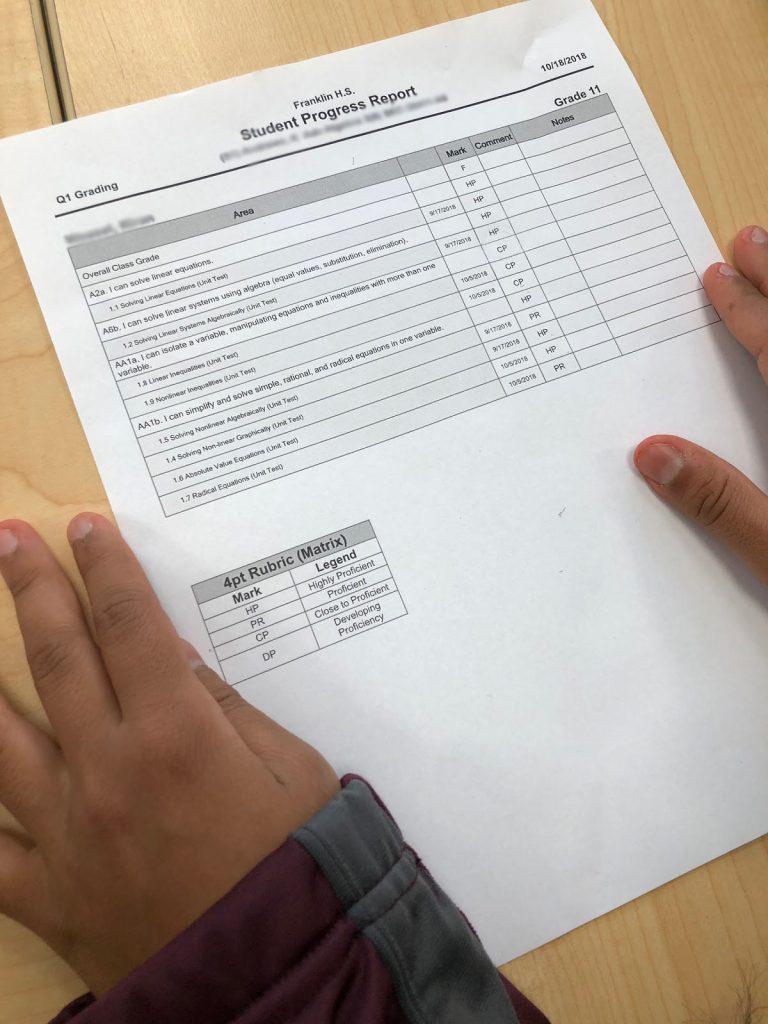
Credit: Bijou Allard
With the pressure from parents, peers, and society to maintain a high GPA, grades are one of the highest sources of stress for high school students. It can be difficult for students to cope with pressure from all directions. The stress can get even worse when they are bombarded with multiple grading systems that can lead to confusion rather than clarity.
Here at Franklin, traditional letter grading on the A-F scale is the standard practice. However some classes use “proficiency-based grading.” A system based on skill sets, proficiency grading targets specific skills students need to know to meet grade-level standards. Unlike letter grades which are based on percentages, proficiency grades are based on how well a student demonstrates their understanding of a learning target. Like letter grading, the scale has four possible scores: Highly Proficient (HP), Proficient (PR), Close to Proficient (CP), and Developing Proficiency (DP).
According to Portland Public Schools, the goal of proficiency-based grading is to “offer an accurate and clear picture of a student’s progress in relationship to grade-level standards,” and to help teachers and students create “a personalized path for learning.” This grading system has some clear benefits, measuring students’ academic progress separate from non-academic factors (like attendance), and focusing more on the performance of individual students rather than an entire class or grade level. However, there are still issues with the system, especially when used in conjunction with letter grading.
This problem is most evident when proficiency grades need to be converted into letter ones for report cards. This conversion doesn’t go as smoothly as one might hope. “For myself and from what I’ve heard from other people, it’s kind of cryptic,” says Lily (10). “Getting a feel for the weight of any given assignment and what effect it will have on your overall grade is difficult.” Franklin physics teacher Scott Barrentine agrees, saying that his students have felt frustrated trying to understand what their final grade will be. Considering that grading is already a point of tension for both students and teachers, proficiency grading has become a catalyst for increased stress in everyone involved.
One reason grade conversions go awry is that Synergy, the program used for grading, does not accurately convert proficiency scores into letters, leaving it up to teachers to do manual conversions. Students like Lily have had first-hand experience with proficiency grading issues. “Last year, one of my teachers told me I earned a B but the grade book hadn’t calculated it. He said he would change it but forgot to, so I have an incorrect grade on my transcript,” Lily says. She believes manual grade conversions are at the heart of proficiency grading issues and that switching to a standard grading system would eradicate conversion issues.
Furthermore, calculating a letter grade from a proficiency grade is far more complex than having letter grades alone. For instance, in Barrentine’s classes there are four learning targets per semester. This means that if a student has all PRs they earn a C. If they have one HP and the other three learning targets are PRs they earn a B. If they have two or more HPs and the rest are PRs, that’s an A. This is further complicated when there is an odd number of learning targets and conversion becomes less exact. With these convoluted conversions it’s easy to see why the system is more puzzling than the round percentages of letter grades and why students like Lily are advocating for a standardized system of grading.
Despite the confusion, teachers like Barrentine endorse the system. “I love the way [proficiency grading] is based around skills that can be practiced and demonstrated in a variety of ways,” he says. Barrentine and other teachers using proficiency-based grading are working to make it better. “This year, progress reports and first- quarter grades will go out without a letter grade; instead, students will have [proficiency grades] in place of a letter ones.”
On its own, proficiency grading is a great way to measure students’ understanding of the material. However, it’s a case of choosing one grading system or another. While teachers like Barrentine are attempting to make improvements to simplify proficiency grade conversion, the situation remains that having two grading systems simultaneously creates unneeded complications. The district needs to officially commit to proficiency grading and establish a contract with a grade book that supports doing it correctly or switch back to a standard grading system. Making these changes will decrease stress in everyone involved and help students and teachers alike.

































